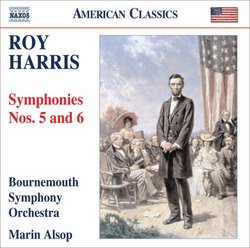Finally, the great Roy Harris!
Brian Ferrell | Jasper, IN USA | 02/09/2010
(5 out of 5 stars)
"Finally, at long last, this beautifully recorded CD does justice to the 5th and 6th Symphonies of Roy Harris. The disgraceful manner in which American orchestras have treated this great composer shows some of the shallowness of our current society. This strong, masculine, yet beautiful music, bleeds American blood. Harris was a greater symphonist than every other American composer, save Schuman and Piston, and is still virtually ignored by all American orchestras.Here, American conductor Marin Alsop plays these works to the hilt. She drives the orchestra and brings out the Harris melodic line better than I've ever heard. What a shame, it took the British orchestra, Bournemouth Symphony, to bring this off. Please listen to these works and get inside the Harris idiom and re-evaluate this composer. You can see and feel the mountains, forests, rivers, pioneers that reflect the true greatness of the United States. Kudos to Naxos! B. G. Ferrell"
Two More Fine Harris Symphonies
J Scott Morrison | Middlebury VT, USA | 02/23/2010
(5 out of 5 stars)
"There is no question that Harris' most famous and beloved symphony is his Third, which has already been recorded in this Naxos series that will possibly record them all. Roy Harris: Symphony No. 3; Symphony No. 4 'Folk Song Symphony'. This disc presents his Symphonies Nos. 5 & 6 (but which are presented in reverse order).
Symphony No. 6, 'Gettysburg', (1944) was written in the midst of World War II at a time when Americans were very much thinking about martial conflict. The symphony is in four movements that limn the Battle of Gettysburg. The movements are called Awakening, Conflict, Dedication and Affirmation. And like good tone-poems, these movements really do create a picture in sound of those phases of the Battle, including memorialization of the dead and affirmation of the necessity of the conflict. Those familiar with Harris' Third Symphony will certainly recognize some of his musical processes used here. There are, for instance, two instances of building excitement via shortening note values and increasingly dense orchestration, a process heard to greater effect in the middle of the Third. One could not ask for a better performance than that given by Marin Alsop and the Bournemouth Symphony.
Included as the last track on this disc is a movement called 'Acceleration' (1941) that contains material later recycled for the 6th Symphony, much of it in the 'Conflict' movement. It is effective in its own right.
The Symphony No. 5 (1942) was written to honor the Russian people's resistance and ultimate victory over the invading Germans early in World War II. When the symphony was premièred by Serge Koussevitsky and the Boston Symphony in 1943 it was broadcast both in the USA and in the Soviet Union. It is in three movements. The first movement, again reminiscent of the section of the Third mentioned above, grows out of a terse theme that is developed via the accelerando/crescendo technique already described. Another aspect of this method is the frequent brassy interjections of two, three, or four note motifs in quicker and quicker succession. The middle movement, itself in three distinct sections, begins with a funeral march and leads into a long section with divided strings playing a striving theme that then culminates in a chorale-like affirmation. The finale is contrapuntal throughout, again in some ways reminiscent of the fugal section of the Third, and it ends in a heroic section that recapitulates the thematic materials from earlier in the movement. On the whole, I must say, I prefer this symphony to the programmatic 6th. But both are strong representatives of Harris's symphonic oeuvre and both are given fine readings here. Recorded sound is quite good.
Scott Morrison"
Gapplegate Music Review, Grego Applegate Edwards, February 2
Grego at Gapplegate Music | New York Metro Area | 03/23/2010
(5 out of 5 stars)
"Naxos Records is in the process of releasing the complete cycle of symphonies by American composer Roy Harris. That can only be a good thing, especially if the present volume is any indication.
Harris's (1898-1979) reputation as an important composer in the modern post-Ivesian mode seems to have waned sometime in the late '50s, only to revive again in the past decade or so. Perhaps it was easy to take him for granted during a period where the very latest advancement of new music got fleeting, flavor-of-the-month attention at the expense of composers who weren't radically breaking with tradition but nonetheless created a body of works that had lasting value.
I do not wish to imply that there isn't much of lasting value in the more avant composers of that era, but that's another matter. Harris was certainly one of those in the less sensational, less "advanced" category, along with Piston, William Schumann and a handful of others. His World War II Era symphonies were more overtly nationalist, at least in sentiment, than some of the earlier and later works. In any event they remain excellent examples of the Harris style, long unwinding melodies changing hands among instrumental groups, crisp, clear orchestrations, a bracing, restrained lyricism. Listen to the sonorous, majestic, martial strains remembered in solitude as worked out in the Second Movement of his Fifth Symphony if you need convincing.
Marin Alsop and the Bournemouth Symphony give carefully but passionately rendered performances of these works. The added bonus of the miniature work "Acceleration," later reworked into the Sixth Symphony, gives a nice finishing touch to the presentation.
Highly recommended listening. . .
[...]"

